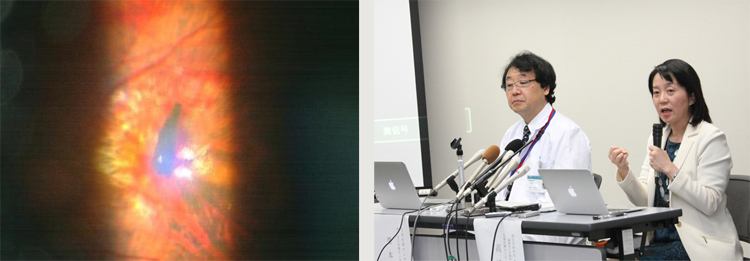
News and Announcements from the CDB
On October 2, a joint press conference was organized by RIKEN, the Foundation for Biomedical Research and Innovation (FBRI), and the Kobe Medical Center General Hospital to report on the progress of the first transplantation of induced pluripotent stem cell (iPSC)-derived retinal pigment epithelial (RPE) cell sheet. The pilot clinical safety study, led by RIKEN CDB’s Masayo Takahashi (Project leader, Laboratory for Retinal Regeneration) and FBRI’s Yasuo Kurimoto (Senior Director of Division of Ophthalmology, IBRI Hospital), targets an eye disease that primarily affects the elderly called, wet-type age-related macular degeneration (AMD), with the aim of establishing a new treatment method for this disease by transplanting an RPE cell sheet generated from a patient’s iPSCs into their eye. The first transplant was performed in September 12, 2014, at the IBRI Hospital in Kobe, Japan.

The research team has been carrying out periodic examinations of the transplant recipient over the past year since the transplantation surgery, including tests of visual acuity, intraocular pressure, ocular fundus and imaging. According to Kurimoto, the overall results of the examinations performed during the monitoring period appear to be good, with the transplanted RPE sheet remaining viable and engrafted in the initial transplantation site. They observed no signs of tumorigenesis or other major abnormalities, as well as no signs of recurring neovascularization. The morphology of the macular region showed signs of improvement since the transplantation. With regards to visual acuity, whereas it had been on the decline prior to the surgery, the patient’s vision appears to have stabilized after the surgery, and the quality of life scores for visual acuity have also improved. Kurimoto emphasized that, while in terms of safety the progress so far looks good, the improvements seen in visual acuity and other factors could be due to the removal of the neovascular tissue prior to transplantation, and that it is difficult to accurately evaluate the effects of the transplanted RPE cell sheet itself at this time. The research team will continue to monitor the patient for the next three years.
“I hope that we can establish a treatment that can be provided to many patients as soon as is possible,” commented Takahashi. “While we should continue to proceed with caution, at the same time, we need to ensure that the research does not come to a standstill.”
Takahashi also expressed her views on treatments tailored for RPE-related diseases, saying that it will require using both autologous and allogeneic iPSC lines as well as preparing both RPE cell sheets and cell suspensions.
| Related link | RIKEN website (News) |
|---|